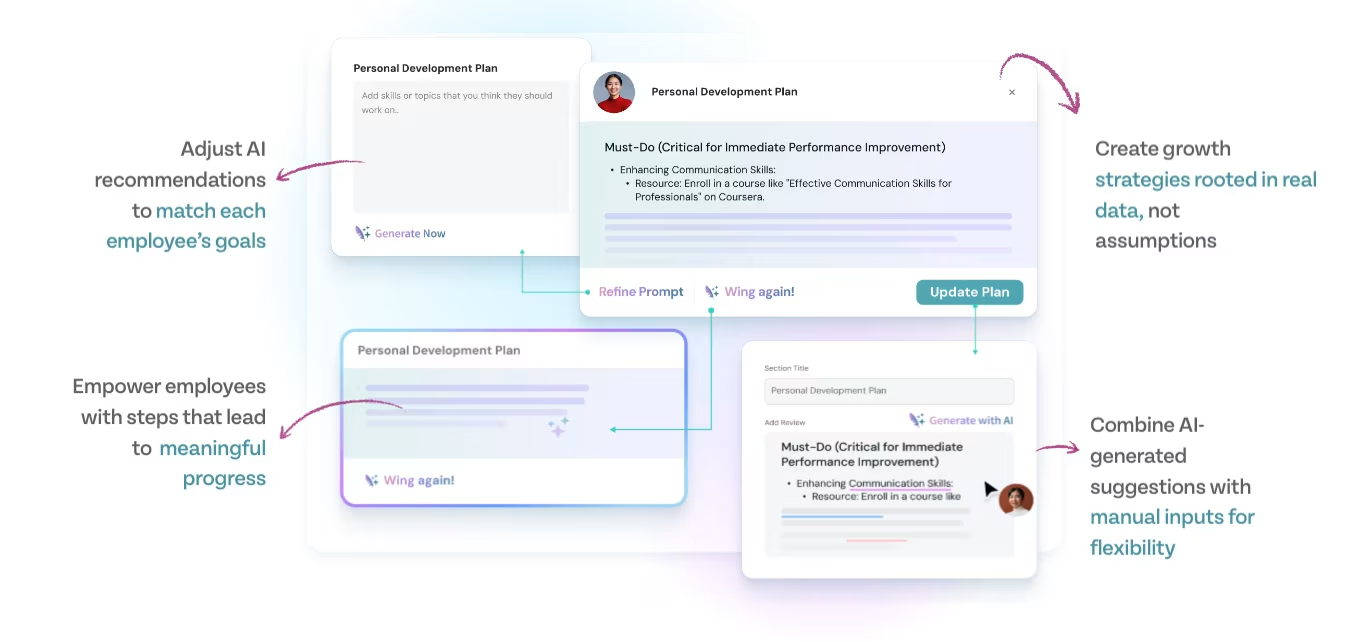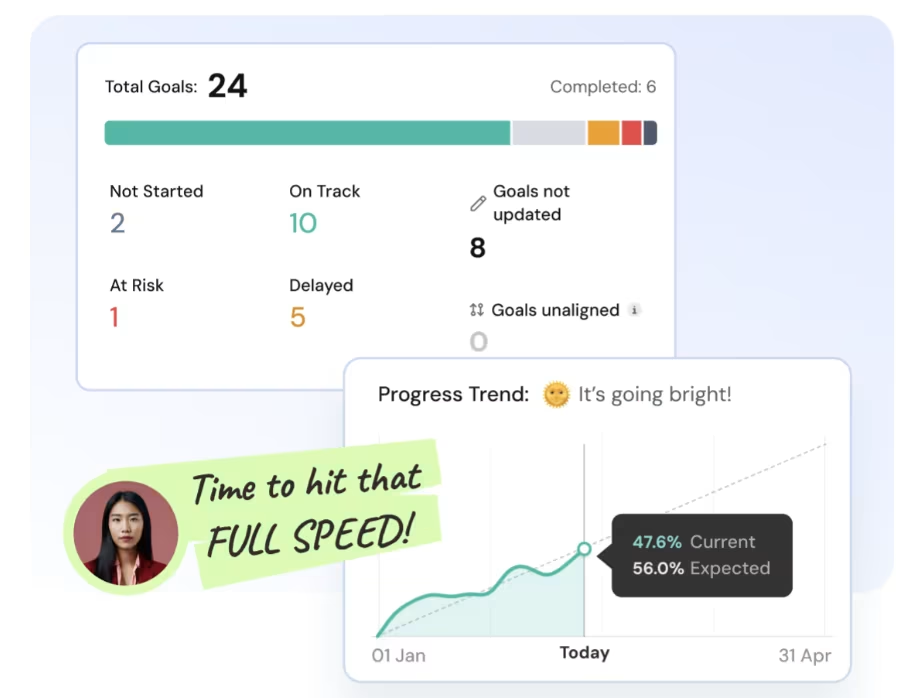Employee engagement is in crisis, and according to gallup's State of the Global Workplace 2025 report shows that global engagement fell to 21% in 2024—the second decline since 2009—costing about $438 billion in lost productivity.
Even more concerning? Only 33% of workers worldwide describe themselves as "thriving," while manager engagement dropped from 30% to 27%.
What makes this particularly challenging is that disengagement spreads like wildfire through teams. As engagement expert Kevin Kruse puts it: "Engagement is not an initiative. It's an outcome of a culture where people are respected and trusted".
The behaviors that signal disengagement often start small and fly under the radar until they snowball into bigger problems that affect everyone. Let's explore seven common habits of disengaged employees and, more importantly, how you can turn them around.
Why this should be on your radar
Disengagement isn't just one person having a bad day—it creates ripple effects throughout your organization. According to leadership firm FranklinCovey has found that when employees become disengaged, they start missing deadlines, their work quality drops, and they bring down team morale, while high‑engagement companies enjoy 23% higher profitability, 14% higher productivity and fewer safety incidents.
The key insight here? Timing matters. Recognizing these habits early allows you to intervene before one person's disengagement becomes a team-wide problem. So let's look at what these warning signs actually look like in practice.
The Seven Habits That Signal Trouble
1. Slipping productivity and missed deadlines
What you'll notice:
That reliable team member who always delivered on time starts missing deadlines or their output drops noticeably. This creates a domino effect that can derail entire projects.
What's really happening:
The root causes usually run deeper than simple laziness. Chronic stress, burnout, or feeling like their workload doesn't match their capacity can erode performance. Sometimes they've lost confidence that their efforts matter, or they believe the goals are unrealistic—leading to a "why bother?" mentality.
Your game plan:
- Lead with curiosity, not judgment. Have an honest conversation to understand whether personal issues, burnout, or unclear expectations are driving the decline. PeopleHR emphasizes that open dialogue helps managers identify the real reasons behind productivity drops.
- Get crystal clear on what success looks like. Provide specific deadlines, necessary training, and proper tools. Make sure workloads are realistic and use metrics to catch issues before they spiral.
- Celebrate progress, not just perfection. Acknowledge their efforts and improvements publicly to show that growth and quality matter just as much as hitting targets.
ThriveSparrow's Kudos makes it simple to celebrate those incremental wins and improvements publicly, turning everyday progress into meaningful recognition that motivates your team to keep growing.

2. Avoiding new challenges and initiative
What you'll notice:
They used to volunteer for projects and suggest improvements. Now they stick to exactly what's assigned and nothing more. PeopleHR reports that this lack of initiative is a telltale sign—employees stop proposing ideas, taking ownership, or stepping up for new opportunities.
What's really happening:
This retreat often happens when their previous initiatives were ignored, their autonomy was restricted, or they fear making mistakes. Self‑determination theory shows us that people need autonomy, competence, and connection to stay motivated—when these needs aren't met, enthusiasm naturally fades.
Your game plan:
- Give them ownership of the "how." Set clear outcomes but let them decide the process. This shift from micromanaging to results-focused leadership can reignite their drive to contribute.
- Make their ideas count. Actively reward effort and celebrate wins, even small ones, to show that taking initiative is valued and safe.
- Create growth opportunities. Offer stretch projects, cross-training, or mentoring. Since lack of development interest is itself a warning sign, continuous learning helps combat stagnation.
ThriveSparrow's AI-powered PDPs create personalized growth roadmaps that connect stretch projects and mentoring opportunities directly to career goals—transforming development resistance into engagement.

3. Withdrawing from the team
What you'll notice:
They respond slowly to colleagues, decline social invitations, and seem to operate in their own bubble. This withdrawal doesn't just affect them—it can drag down team energy if left unaddressed.
What's really happening:
Withdrawal is often self-protection. It might stem from burnout, feeling undervalued, conflicts with teammates, or personal struggles. Sometimes it signals a mismatch between their values and your company culture.
Your game plan:
- Check in privately first. Have a genuine one-on-one to show you care and understand what's driving their distance. If personal issues are involved, consider involving HR or professional support.
- Build psychological safety. Create an environment where people feel safe expressing concerns without fear of retaliation. When contributions are recognized and valued, collaboration becomes more appealing.
- Start small with reconnection. Pair them with a mentor or include them in low-pressure group projects to gradually rebuild their confidence and team connections.
4. Resisting learning and development
What you'll notice:
They used to be first in line for training sessions. Now they skip development programs or show visible disinterest when learning opportunities arise. ActivTrak notes that disengaged employees simply don't volunteer for new learning experiences.
What's really happening:
This resistance often signals deeper disconnection. If their role doesn't align with career aspirations, or they don't see growth potential, they stop investing in themselves. Burnout and feeling undervalued can also kill their motivation to learn
Your game plan:
- Connect today's learning to their future goals. Discuss their long-term aspirations and help them see how current opportunities support those dreams. Involve them in planning their own development path.
- Make learning accessible and relevant. Provide dedicated time and budget for courses, conferences, or job rotations that benefit both them and your organization.
- Encourage peer teaching. Create opportunities where employees share knowledge with each other—this deepens skills while strengthening team bonds.
5. Decline in work quality and increased mistakes
What you'll notice:
The work gets done, but it's not up to their usual standards. More errors, less attention to detail, and a general sense they're going through the motions.
What's really happening:
Quality decline often reflects mental checkout. When people are distracted, overwhelmed, or lacking skills for evolving responsibilities, their work suffers. Sometimes it's also about unclear expectations or insufficient feedback about standards.
Your game plan:
- Address the gap directly but kindly. Discuss the difference between current output and expectations without making it personal. Encourage questions and clarify what "good" looks like.
- Break challenges into smaller wins. Set short-term, achievable goals to rebuild confidence and momentum while working toward bigger objectives.
ThriveSparrow’s Goals tool helps you turn big objectives into smaller, achievable wins—making progress visible, alignment effortless, and confidence easy to rebuild, one milestone at a time.
- Invest in their capabilities. Provide targeted training or pair them with a mentor to address skill gaps that might be contributing to quality issues.

6. Frequent absenteeism and "quiet quitting"
What you'll notice:
More sick days, late arrivals, or unscheduled breaks. But it's not just physical absence—some engage in "quiet quitting," where they're present but doing the absolute minimum.
What's really happening:
Absence becomes a coping mechanism. Whether it's stress-related health issues, burnout, or lack of motivation, employees may use time off as their way of managing overwhelming feelings about work.
Your game plan:
- Understand before you react. Instead of jumping to discipline, explore whether workload, health issues, or personal circumstances are contributing. Consider supportive policies like occasional mental health days.
- Address work-life balance proactively. Offer flexible hours, remote options, or wellness programs to help them manage stress before it leads to frequent absences.
- Be clear but compassionate. Remind them of attendance expectations while showing empathy for genuine needs and working together on solutions.
7. Negative attitude and toxic influence
What you'll notice:
This is the most visible and contagious habit. Frequent complaints, defensive body language, and undermining colleagues. ActivTrak describes how these employees can poison team dynamics , while PeopleHR notes that negativity spreads throughout the team. Warning signs include constant complaints, lack of meeting participation, and non-verbal cues like eye-rolling.
What's really happening:
Negativity usually stems from feeling unheard, experiencing unfair treatment, or having unresolved conflicts with leadership. When people feel their concerns aren't acknowledged or their contributions don't matter, cynicism takes root.
Your game plan:
- Create safe channels for input. Provide structured ways for them to express concerns and suggestions—then act on what you can. Show that their feedback has value by following up and implementing changes when possible.
- Model the behavior you want. Maintain supportive, positive communication and regularly recognize achievements. You set the tone for how team members interact.
- Address toxicity when necessary. When negativity becomes destructive, involve HR and set clear boundaries to protect your team's overall health.
The ripple effect nobody talks about
Here's what many leaders miss: disengagement rarely stays contained. But here's the kicker—Gallup found that 70% of team engagement variance comes from the manager.
When managers themselves are disengaged—and manager engagement dropped from 30% to 27% last year—their teams inevitably follow. Think of it as an emotional thermostat: the leader's engagement level sets the temperature for everyone else.
The flip side? Engaged leadership creates powerful positive effects. Teams with engaged managers deliver higher productivity, better attendance, fewer accidents, and stronger customer loyalty. With $438 billion in global productivity at stake , getting this right isn't optional.
Building disengagement resistance
Prevention beats cure every time. Here's how smart leaders create environments where disengagement struggles to take hold:
1. Develop your managers first:
Only 44% of managers receive formal management training , but when they learn to coach rather than control, teams see 22% higher engagement and 20-28% better performance.
I feel that the culture starts with your management team first.
2. Focus on what humans actually need:
Self-determination theory shows people thrive when they feel autonomous, capable, and connected. This means flexible work arrangements, real growth opportunities, and fostering genuine belonging.
3. Make feedback continuous, not annual:
Regular one-on-ones, recognition programs, and structured ways for employees to give input create cultures where contribution matters.
4. Connect work to purpose:
Help people understand how their daily tasks support your organization's mission. When they can see beyond their to-do list to the bigger picture, work becomes more meaningful.
Recognizing disengagement early isn't just good management—it's smart business. When you spot these seven warning signs, you're seeing employees who need support, not discipline. Don't wait for exit interviews to learn what went wrong. Start paying attention to the small signals now. Have those conversations. Show genuine interest in your team's experience.
Try ThriveSparrow free for 14 days! No credit card required.
FAQs
1. What's the main cause of employee disengagement?
It's usually a combination of chronic stress, lack of recognition, misaligned values, poor leadership, and limited growth opportunities. Rarely is it just one factor—it's typically several issues compounding over time.
2. How can I spot disengaged employees before it gets worse?
Watch for patterns in productivity decline, missed deadlines, social withdrawal, lack of initiative, and increased absences. Regular check-ins and pulse surveys help surface issues early, before they spread to other team members.
3. What's the difference between disengaged and unengaged employees?
Disengaged employees have emotionally checked out and may actively spread negativity, while unengaged employees simply don't invest extra effort. Both need support, but disengaged employees pose greater risks to your team culture.
4. Do learning opportunities really help with engagement?
Absolutely. Resistance to development is often an early warning sign. When you connect current roles to future career paths and provide relevant, accessible training, people start feeling valued and capable again.
5. How much does disengagement actually cost organizations?
The numbers are staggering—disengaged teams consistently underperform engaged ones in profitability, attendance, and customer loyalty. Globally, we're talking about $438 billion in lost productivity annually , making this one of the most expensive workplace challenges.
















